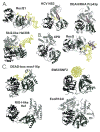Superfamily 2 helicases
- PMID: 22652765
- PMCID: PMC3775597
- DOI: 10.2741/4038
Superfamily 2 helicases
Abstract
Superfamily 2 helicases are involved in all aspects of RNA metabolism, and many steps in DNA metabolism. This review focuses on the basic mechanistic, structural and biological properties of each of the families of helicases within superfamily 2. There are ten separate families of helicases within superfamily 2, each playing specific roles in nucleic acid metabolism. The mechanisms of action are diverse, as well as the effect on the nucleic acid. Some families translocate on single-stranded nucleic acid and unwind duplexes, some unwind double-stranded nucleic acids without translocation, and some translocate on double-stranded or single-stranded nucleic acids without unwinding.
Figures




References
-
- Pyle Anna Marie. Translocation and unwinding mechanisms of RNA and DNA helicases. Annu Rev Biochem. 2008;37:317–336. - PubMed
-
- Gorbalenya Alexander E, Koonin Eugene V, Donchenko Alexi P, Blinov Vladimir M. Two related superfamilies of putative helicases involved in replication, recombination, repair and expression of DNA and RNA genomes. Nucleic Acids Res. 1989;17:4713–4730. doi: 10.1093/nar/17.12.4713. - DOI - PMC - PubMed
Publication types
MeSH terms
Substances
Grants and funding
LinkOut - more resources
Full Text Sources
Other Literature Sources

